Systematic-Review-Drug-Efficiency-Dissertation-Sample-Work-Tutors-India
Idiopathic Pulmonary Fibrosis (IPF) as the name suggests is a progressive disorder with no known aetiology. It is characterised by the thickening of the alveoli due to scarring resulting in cough. It is known to primarily occur in older adults over 60 years of age. The findings of IPF have a known association of Usual Interstitial Pneumonia (UIP) (Raghu et al., 2011; Kawano-Dourado & Kairalla, 2013; Wells, 2013). It has been deemed that the prognosis is generally poor when UIP has been confirmed (King et al., 2001b). The median survival rate of IPF is 50%, typically around two years after diagnosis (Raghu et al., 2011; King et al., 2001b).
Idiopathic Pulmonary Fibrosis (IPF) as the name suggests is a progressive disorder with no known aetiology. It is characterised by the thickening of the alveoli due to scarring resulting in cough. It is known to primarily occur in older adults over 60 years of age. The findings of IPF have a known association of Usual Interstitial Pneumonia (UIP) (Raghu et al., 2011; Kawano-Dourado & Kairalla, 2013; Wells, 2013). It has been deemed that the prognosis is generally poor when UIP has been confirmed (King et al., 2001b). The median survival rate of IPF is 50%, typically around two years after diagnosis (Raghu et al., 2011; King et al., 2001b).
Create successful ePaper yourself
Turn your PDF publications into a flip-book with our unique Google optimized e-Paper software.
cohort) of 14.6 per 100,000, while prevalence was 58.7 per 100,000 (Esposito et al., 2015).<br />
The computed annual incidence/prevalence per 100,000 in Europe was 0.22/1.25 in Belgium,<br />
0.94/6.5-12.1 in the Czech Republic, 0.93/3.38 in Greece, 2.17/NA in Denmark, 3.0/NA in<br />
Spain, 4.3/23.4 in Norway, and 7.94/NA in the United Kingdom (Kuwano et al., 2016). A<br />
study described the incidence/prevalence as 2.23/10.0 per 100,000 in Japan (Kuwano et al.,<br />
2016).<br />
The cause of IPF is unknown but is expected to be related with a variety of risk<br />
factors, comprising of cigarette smoking, viral infections and occupation (Baumgartner,<br />
2000). The most common collection of risk factors is exposure to inhalation agents, with<br />
extended, repeated injury to the lungs substantially causing the fibrotic approaches (Kuwano<br />
et al., 2016). IPF has also been perceived to appear in a familial pattern (influencing two or<br />
more individuals of an immediate family), though the appearance of such familial cases<br />
differs in studies between 2% and 25% of all IPF cases (Tang et al., 2003). One study<br />
inference that among all the risk factors related with IPF, the highest single risk factor was to<br />
have a parent or sibling with IPF (odds risk (OR) = 6.1) (García-Sancho et al., 2011).<br />
Other than the genetic and environmental factors described above, there are numerous<br />
medical conditions that incline to represent parallel to IPF. The 126 studies examined by<br />
literature review conducted from 1990 to 2015, described remarkable comorbidities related<br />
with IPF. The respiratory comorbidities were as follows: pulmonary hypertension (34%),<br />
chronic obstructive pulmonary disease (18%), lung cancer (15%), obstructive sleep apnea<br />
(6%), and pulmonary embolism (2%). The non-respiratory comorbidities comprised of<br />
cardiovascular disease (27%), metabolic disease (24%), and gastro-esophageal reflux disease<br />
(18%) (Raghu et al., 2015a). The category of these relations, whether they are causal or share<br />
common risk factors (e.g., age), has not been described.<br />
2.2.1 Idiopathic pulmonary fibrosis as an Interstitial Lung Disease<br />
New international definitions, guidelines, classifications and treatment probabilities in<br />
current years, have progressed in interstitial lung disease (ILD) and precisely in IPF. The<br />
word ILD describes more than 200 different establishments. In 1960’s the first pathologic<br />
categorization was defined, and in the subsequent 20-30 years no clear differentiation was<br />
© 2017-2018 All Rights Reserved, No part of this document should be modified/used without prior consent<br />
<strong>Tutors</strong> <strong>India</strong> - Your trusted mentor since 2001<br />
www.tutorindia.com I UK # +44-1143520021, info@tutorsindia.com<br />
Page 18 of 172


















